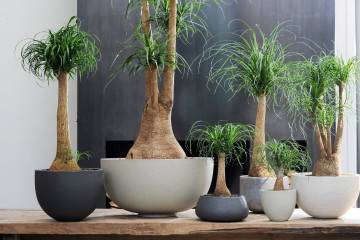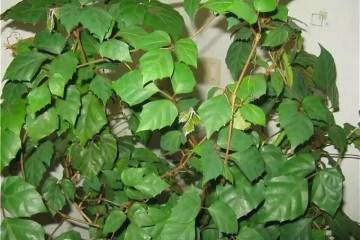Scindapsus golden - home care
Content:
The decorative home flower, scindapsus, or devil ivy, is a fairly common houseplant. The exotic liana grows rapidly, is able to climb a fleecy support, braid wire structures. Surprises with a variety of colors and shapes of leaves. At the moment, more than 25 plant species have been bred.
What does it look like, which family it belongs to
Scindapsus are a genus of tall evergreen lianas of the Aroid family that grows in the wild in the tropical forests of Southeast Asia. The leaves are dense, leathery in some species, they are light and dark in color. The spots are small, large in the form of strokes. The branches of indoor species reach 3 meters, in the wild they grow up to 10 meters.

Scindapsus Painted is often grown as an ampelous plant. Prized for its silvery brush strokes on large, asymmetrical, heart-shaped leaves.
The roots of the plant are of two types:
- underground, which hold the plant in the soil, absorb nutrients from the ground;
- air, which capture moisture and nitrogen from the air.
Briefly about the history of appearance
According to legend, the vine began to be bred to scare away the devil, therefore the second name of the vine is devil ivy. Biologists from European countries immediately drew attention to the culture, which is unpretentious in care, and began to engage in the selection of new species. Scindapsus are often called epipremnums.
Homeland of plants
- Spotted and Painted Scindapsus with ovoid variegated leaves are found in Malaysia and Indonesia;
- Golden - in American selection;
- Scindapsus Moonlight has leathery dark green leaves that grow at a short distance from each other. Homeland Malaysia;
- Joy is a Dutch hybrid, not susceptible to disease;
- Neon is another Dutch look, featuring light green greens with light strokes;
- Marble Queen or "Marble Queen" - a hybrid of English botanists based on a plant brought from Thailand;
- The new cultivar Scindapsus Godzilla from Japan has unusual, elongated, crinkled leaves; the cultivar is bred on the basis of a vine growing in Mali;
- Troiba with dark elongated leaf plates is found on the islands of Java, Borneo.
Features of home care
For normal growth in an apartment, in a winter garden, conditions close to tropical are created for the plant.
Temperature
In the summer, the liana feels good if the air is warmer than + 19 ° С, but does not heat up above + 27 ° С. Recommended mode in winter: + 15… 19 ° С.
Lighting
Syndapsus grow in forests. The plant does not like direct sunlight, grows well on the east and west sides. In the southwest, southeast, the flower is shaded.
Watering
It is recommended to moisten the earthen lump as it dries, in the spring the volume of water is increased, in the winter it is reduced. For irrigation, use a filtered or settled water supply for three days.
Spraying
Vines growing near batteries, with the onset of the heating season, need regular spraying.
Humidity
The plant is comfortable with a humidity of at least 50-60%. In summer, scindapsus lives well on an open loggia, balcony.
Priming
For cultivation, they acquire a universal soil for home flowers or make a soil mixture of turf and leaf (compost) soil in a ratio of 1: 3; for looseness, the soil is filled with dry peat, vermiculite or sand at the rate of: a glass of baking powder for 5 liters of the mixture.

Scindapsus Pictus is easy to recognize by its variegated colors, intricately curved branches. The bush turns out to be compact, decorative
Top dressing
Root feeding is recommended for syndapsus. Universal complexes for home flowers are applied to the soil dissolved with water for irrigation. Fertilizers are applied once a season, with the onset of spring.
Support
If you need to form a tall bush, a direct support is installed in the pot at a distance of 5 cm from the stem. The plant can be given any shape using flexible rods, thick wire. If desired, the vine is tied to carnations driven into the wall.
Scindapsus blooms or not
If the flower is properly cared for over the years, you can achieve flowering at home. A cob-shaped inflorescence appears. But more often the plant is used for decorative greenery.
Pruning
Trimming is done with rubber gloves, goggles, gauze bandage. After work, the clothes are immediately sent to the wash.
Scindapsus Golden is in special demand among florists; when leaving at home, formative pruning is carried out annually. Sanitary pruning to remove damaged leaves and shoots is not limited in time. You can maintain the appearance of a flower at any time of the year.
Crown formation
In the spring, frail and unnecessary shoots are removed, long branches are shortened. Cut out up to 1/3 of the crown at a time.

High-quality planting material takes root well; aloe juice is used to stimulate growth. The leaves are pre-kept in the refrigerator for 5 days
How does it multiply
Wild scindapsus in nature reproduces by seeds and air layers growing to the ground. Indoor species are bred by cuttings and layering.
Transfer
The vine is moved to a new pot when the old one becomes cramped. The container should be in height, 5 cm larger in diameter. Drainage is laid at the bottom, sprinkled with earth. The liana is transplanted by the transshipment method, without destroying the earthen coma. It is allowed to shorten it by 1/3 in order to increase the layer of fertile land. Dividing the bush during transplantation is allowed. The procedure is carried out at the very beginning of spring, when new leaf buds wake up.
Cuttings
- shoots with 3 leaves break off in early spring in the growth phase;
- placed in a glass of water, add a few drops of a growth stimulant;
- after the formation of a bunch of roots, they are rooted in a pot.
Taps
This plant reproduction is the simplest. The aerial roots of the scindapsus are pinned to the soil, then the rosettes are separated.
Possible growing problems
For vines, putrefactive diseases are characteristic. Fungi develop with a lack of drainage, frequent watering. Flowers are treated with fungicides. The safest is Fitosporin. If mold occurs at the root neck, take out the vine from the pot. Rinse the pot well, fill it with a new substrate. The roots are separated from the ground, washed in a solution of potassium permanganate, then transplanted.
Pests
The wind brings insects, they can be brought in with bouquet or potted flowers from the store. Spider mites, scale insects, thrips are destroyed with intestinal acaricides Aphids are afraid of insecticides.
Other problems
- leaves begin to curl at low humidity;
- dark burns appear on the leaves from the sun;
- from hypothermia in a draft, the leaves darken and fall off;
- leaves darken when there is not enough light;
- baldness occurs in the shade of the creeper - the plant sheds its foliage.
Scindapsus Golden and other varieties of lianas of this species purify the air well. They will become a highlight of the interior, decorate the room. The plant is unpretentious in care; novice gardeners will be able to grow it.


















